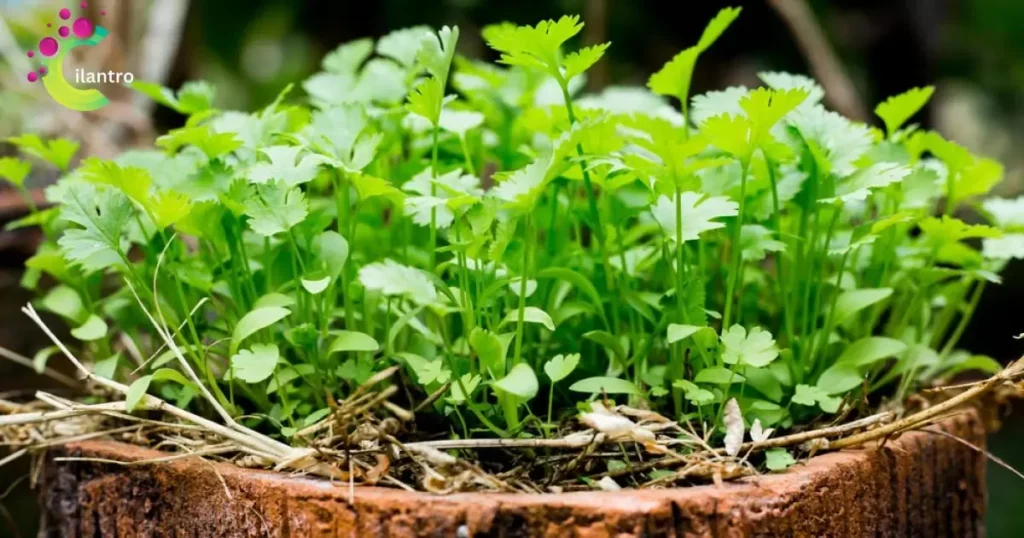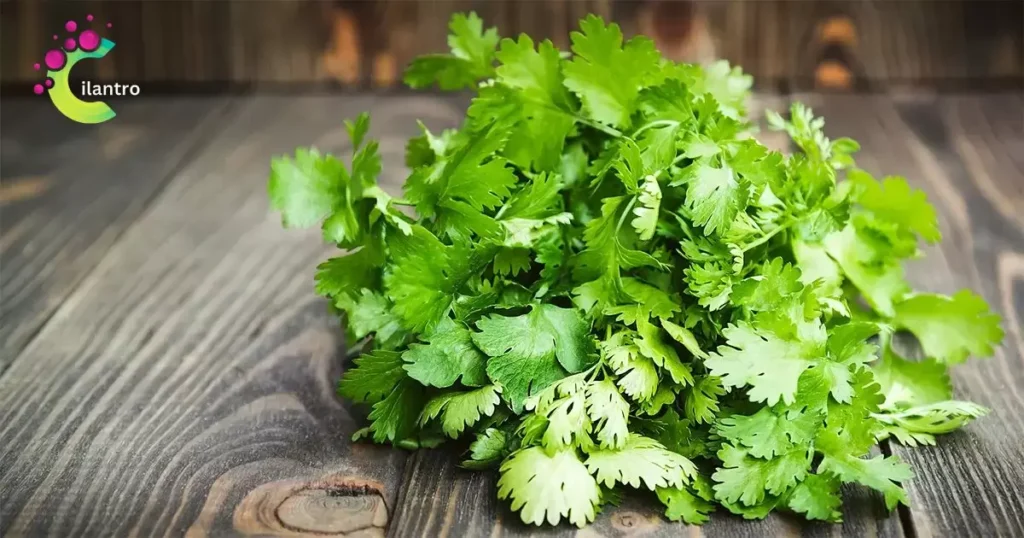Cilantro, an herb with vibrant green leaves, typically requires consistently moist soil. Water it when the top inch of soil feels dry to the touch, ensuring adequate hydration for optimal growth.
It’s simple cilantro likes consistent moisture. Ensure the soil is evenly damp but not waterlogged. Give it a good drink when the top inch of soil feels dry. The question is here, How much water does cilantro need? It’s straightforward cilantro enjoying water. Keep the soil evenly damp, avoiding waterlogging. Finding the right balance keeps cilantro happy and thriving.
The herb cilantro, which has bright green leaves and a distinctive flavor, requires consistent watering for optimal growth. Water the soil evenly, keeping it consistently moist but not waterlogged. Aim for about 1 to 1.5 inches of water per week, either from rainfall or irrigation. Adjust the watering frequency based on weather conditions and ensure good drainage to prevent root rot.
How often do Water Cilantro Plants?
Watering cilantro plants depends on factors like weather and soil moisture. Cilantro prefers consistently moist soil, so water when the top inch of soil feels dry. In hot weather, this may mean watering every 2-3 days, while in cooler conditions, it could be less frequent.
To enhance the flavor profile of your culinary creations, consider incorporating cilantro lime rice into your dishes. However, when cultivating cilantro, it’s crucial to avoid overwatering to prevent root rot and ensure good drainage in the soil. Adjust the watering frequency based on environmental conditions, always prioritizing proper drainage to maintain robust and healthy cilantro growth.
Watering an established Cilantro Plant
To properly water an established cilantro plant, ensure the soil remains consistently moist but not waterlogged. Water deeply when the top inch of soil feels dry to the touch. Avoid overhead watering to prevent fungal issues. Provide good drainage to prevent root rot, and consider mulching to retain soil moisture.
Water the plant at its base, avoiding overhead watering, to prevent fungal issues. Allow the top inch of soil to dry before watering again. Use well-draining soil to prevent root rot. Adjust the frequency of watering based on environmental conditions; during hot weather, cilantro may require more frequent watering.
When to water cilantro that is planted outside
Water cilantro planted outside when the top inch of soil feels dry to the touch. Provide consistent moisture, aiming for about 1 to 1.5 inches of water per week, adjusting based on weather conditions. Ensure proper drainage to prevent waterlogging, allowing the soil to dry slightly between watering sessions.
- When to water cilantro that is planted inside
Water cilantro planted indoors when the top inch of the soil feels dry to the touch, addressing cilantro need. Ensure the container has drainage holes to prevent overwatering. Water sparingly, as cilantro prefers slightly drier conditions and may suffer from root rot if kept consistently moist.
- When to water cilantro planted in the landscape
To keep cilantro thriving in your garden, water it consistently. Give it a good soak when the top inch of soil feels dry. Water in the morning to prevent fungal issues. Adjust watering based on weather conditions to keep your cilantro happy and flavorful.
- When to water cilantro planted in containers
Watering cilantro in containers is crucial for its health. Check the soil moisture regularly by inserting your finger into the soil up to the first knuckle. Water when the top inch feels dry. Ensure proper drainage to prevent overwatering, as cilantro doesn’t like soggy soil. Adjust the frequency based on the weather and container size for thriving cilantro plants.
Watering cilantro seedlings

Watering cilantro seedlings is crucial for their growth. Begin by ensuring the soil is consistently moist but not waterlogged. Use a watering can with a fine spray or a gentle hose nozzle. How much water does cilantro Need? Water the soil around the seedlings, avoiding direct water on the delicate leaves. Provide enough water to keep the soil evenly damp.
Check the soil moisture regularly, as cilantro prefers consistent hydration. Overwatering can lead to root rot, so moderation is key. Aim for balance, and your cilantro seedlings will thrive with proper care.
Watering Cilantro the Right Way: Expert Tips
Watering cilantro properly is crucial for its growth. Cilantro need consistent moisture, but it’s essential to avoid waterlogging the soil. Water the plant at its base to prevent water from entering the leaves. Use a watering can with a gentle flow. Allow the top inch of soil to dry between waterings. Cilantro prefers slightly damp conditions. Morning watering is ideal, as it allows the plant to dry before evening. Overwatering can lead to root rot, so moderation is key for healthy cilantro plants. Here are the following expert tips to keep your cilantro thriving:
Timing Matters
Water cilantro in the morning to allow the soil to absorb moisture before the heat of the day. Avoid evening watering to prevent prolonged dampness, reducing the risk of fungal issues.
Soil Moisture Check
Ensure the top inch of soil is dry before watering. Stick your finger into the soil; if it feels dry, especially in the context of cilantro needs, it’s time to water.
Gentle and Consistent
Use a gentle stream of water to avoid displacing seeds or young plants. Consistency is key; maintain a regular watering schedule rather than occasional heavy watering.
Root-Focused Hydration
Direct water at the base of the cilantro plants to reach the roots effectively, especially when cilantro needs sufficient hydration. Deep, infrequent watering encourages robust root development and overall plant health.
Mulching Magic
Apply a layer of organic mulch around the cilantro plants to retain soil moisture and meet their cilantro needs. Mulching also helps control weeds, providing a conducive environment for cilantro growth.
Adapt to Weather Conditions
Adjust your watering routine based on weather conditions; hotter and drier climates may require more frequent watering. During rainy periods, reduce watering to prevent over-saturation and potential root rot.
Important Things to consider
- Cilantro prefers well-draining soil to prevent waterlogged roots.
- Water consistently but avoid overwatering, as cilantro is susceptible to root rot.
- Provide regular, moderate watering, especially during dry periods.
- Water at the base of the plant to keep the foliage dry and prevent disease.
- Adjust watering frequency based on environmental factors, such as temperature and humidity, to maintain optimal cilantro growth.
How to Determine if Your Cilantro Needs Water?

To determine if your cilantro needs water, assess the soil moisture by inserting your finger into the soil up to 1 inch deep. If the soil feels dry at this depth, it’s time to water. It observes the cilantro plants for signs of wilting or drooping leaves, which indicate dehydration.
Monitor the weather conditions, as hot and dry periods may require more frequent watering. Ensure proper drainage in the planting area to prevent waterlogged soil. Establish a consistent watering schedule, allowing the soil to dry slightly between each watering to meet the cilantro need and maintain optimal moisture levels for healthy cilantro growth.
Check the Soil Moisture
Insert your finger into the soil up to the first knuckle. If it feels dry, your cilantro may need water.
Look for Wilting Leaves
If the cilantro leaves appear droopy or wilted, it’s a sign that the plant is thirsty and requires watering.
Assess Leaf Color
Healthy cilantro has vibrant green leaves. If the leaves start turning yellow or brown, it could indicate a lack of water.
Check the Soil Surface
A dry and crusty soil surface is a clear indication that the cilantro plant needs watering.
Evaluate the Container Weight
Lift the pot or container. If it feels light, it’s a sign that the soil is dry and the cilantro needs watering.
Monitor Weather Conditions
Hot and dry weather increases the water needs of cilantro. During such conditions, check the soil more frequently.
Establish a Watering Schedule
Create a consistent watering routine based on the cilantro’s needs. Water deeply, but allow the soil to dry out slightly between watering sessions.
Use a Moisture Meter
Invest in a moisture meter to accurately measure the moisture level in the soil. This tool can help you determine when it’s time to water your cilantro.
Your cilantro plant may wilt with too much water or too little

Cilantro plants require a balanced approach to watering, as both overwatering and underwatering can lead to wilting. Excessive moisture can lead to root rot and wilting, while insufficient water can cause dehydration and drooping leaves.
It is crucial to maintain a consistent watering schedule, allowing the soil to dry slightly between waterings to prevent waterlogged conditions. Monitoring soil moisture levels and adjusting watering accordingly will help meet the cilantro plant’s specific cilantro needs, keeping it healthy and vibrant.
Overwatering and Underwatering: Problems and Solutions
Here’s a table outlining common problems associated with overwatering and underwatering cilantro, along with their respective solutions:
| Problem | Symptoms | Overwatering Solutions | Underwatering Solutions |
| Yellowing Leaves | – Wilting, but soil is consistently damp | – the watering frequency to allow soil to dry between waterings | – Increase watering frequency to keep soil consistently moist |
| Root Rot | – Foul odor from soil, mushy roots | – Improve soil drainage by adding perlite or sand to the mix | – Water more frequently and ensure proper drainage |
| Fungal Diseases | – Dark spots on leaves, moldy appearance | – Water in the morning to allow excess moisture to evaporate quickly | – Provide adequate moisture while avoiding waterlogged conditions |
| Stunted Growth | – Lack of new growth, overall small size | – Reduce watering frequency to prevent waterlogged soil | – Increase watering frequency and ensure soil is consistently moist |
| Drooping and Yellowing | – Soft, limp stems and yellowing of leaves | – Allow the soil to dry out between waterings | – Water the cilantro more frequently to revive wilted plants |
| Edema | – Blisters or bumps on the underside of leaves | – Reduce watering frequency to prevent water absorption through leaves | – Ensure consistent moisture without overwatering to prevent edema |
| Mold Growth | – White or gray mold on the soil surface | – Improve air circulation around the cilantro | – Adjust watering to keep the soil surface dry and prevent mold growth |
Remember, the ideal watering regimen for cilantro depends on various factors like the climate, soil type, and pot size. It’s essential to monitor the plant regularly and adjust watering practices accordingly.
Finding the Sweet Spot for Cilantro
Achieving the ideal growing conditions for cilantro need involves finding the sweet spot in terms of sunlight and temperature. Cilantro thrives in partial shade with well-drained soil, requiring approximately 6 hours of sunlight daily.
Maintaining a consistent temperature between 50-85°F (10-29°C) encourages robust growth. Adequate moisture, not too dry or waterlogged, completes the optimal environment for cultivating flavorful and healthy cilantro.
How Often to Water Cilantro: A Practical Guide
The frequency of watering cilantro depends on factors such as climate, soil, and potting conditions. Generally, cilantro prefers consistently moist soil. In moderate climates, watering every 2-3 days is often sufficient, while in hot or dry conditions, more frequent watering may be necessary.
It’s essential to monitor the soil moisture levels and adjust watering accordingly, ensuring the top inch of soil remains slightly damp. Overwatering should be avoided, as cilantro is susceptible to root rot. Container-grown cilantro may need more frequent watering than those planted directly in the ground.
Regular observation and adjusting watering practices based on environmental conditions are key to maintaining healthy cilantro plants.
FAQ’s
How much water does cilantro need per day?
Cilantro typically requires about 1 inch of water per week, equivalent to approximately 0.14 inches per day.
How much sun and water does cilantro need?
Cilantro requires full sun and well-drained soil, with regular watering to keep the soil consistently moist.
Can cilantro be overwatered?
Yes, cilantro can be overwatered, leading to root rot and other issues.
Are there any benefits to harvesting cilantro seeds?
Harvesting cilantro seeds allows for the production of coriander spice, providing a distinct flavor and various health benefits.
How many cilantro plants do I need?
The number of cilantro plants needed depends on your consumption and gardening space, but typically 3-4 plants per person should be sufficient.
Do cilantro plants have seeds?
Yes, cilantro plants produce seeds, commonly known as coriander seeds, after flowering. These seeds are used as a spice in cooking.
Conclusion
Cilantro, also known as coriander, requires a careful balance of water to thrive. While it is essential to keep the soil consistently moist during its early growth stages, cilantro is susceptible to root rot if overwatered. Striking the right balance is crucial for optimal growth and flavor development. Adequate drainage is equally important, preventing waterlogged conditions that can stunt the plant’s growth.
Observing the plant’s response to watering and adjusting based on environmental factors, such as temperature and humidity, is key to successful cilantro cultivation. How much water does cilantro need? Remembering that cilantro originates from regions with diverse climates helps tailor watering practices to mimic its natural habitat. By understanding the nuanced water needs of cilantro, gardeners can cultivate a robust and flavorful herb, enhancing culinary experiences while fostering sustainable gardening practices.

Meet our website’s admin, a culinary enthusiast dedicated to curating delectable food ideas. With a passion for gastronomy, they expertly craft and present a diverse array of recipes, tips, and inspirations, making our platform a go-to destination for culinary creativity.











